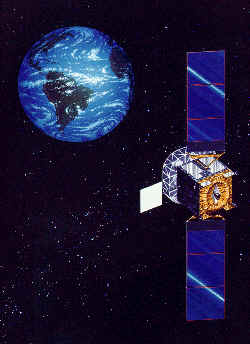Engineering:UHF Follow-On (satellite)
This article includes a list of references, related reading or external links, but its sources remain unclear because it lacks inline citations. (January 2018) (Learn how and when to remove this template message) |
 Artist's impression of an UHF Follow-On satellite in orbit | |
| Country of origin | United States |
|---|---|
| Operator | United States Navy |
| Applications | Military communications |
| Specifications | |
| Bus | HS-601 |
| Design life | 14 years (planned) |
| Launch mass | 2,844 kg (6,270 lb) |
| Regime | Geosynchronous orbit |
| Dimensions | |
| Production | |
| Status | Active |
| Built | 11 |
| Launched | 11 |
| Lost | 1 |
| Maiden launch | 25 March 1993 |
| Last launch | 18 December 2003 |
Ultra High Frequency Follow-On (UFO) satellite system is a United States Department of Defense (DoD) program sponsored and operated by the United States Navy to provide communications for airborne, ship, submarine and ground forces. The UFO constellation replaced the U.S. DoD Fleet Satellite Communications System (FLTSATCOM) constellation and consisted of eleven satellites. The ground terminal segment consists of equipment and resident personnel at existing satellite communication stations. The satellites are controlled by the Naval Satellite Operations Center (NAVSOC) located at the Naval Base Ventura County, Point Mugu, California .
Satellite description
The Ultra high frequency (UHF) satellites primarily served tactical users. UFO provided almost twice as many channels as FLTSATCOM and has about 10% more power per channel. The Extremely high frequency (EHF) package on satellites four through eleven have an Earth coverage beam and a steerable five-degree spot beam that enhances its tactical use. The EHF capability also allows the UFO network to connect to the strategic Milstar system. Satellites eight, nine and ten also carry the Global Broadcast Service antennas that operate in the Ka-band. The Atlas was the launch vehicle of choice; however, space shuttle compatibility existed. The UFO bus and payload weigh 2,844 kg (6,270 lb).[1] The solar panels spans 18.4 m (60 ft) and produces 2,500 watts at the end of the planned 14-year lifetime. The UHF system supports stationary and mobile users including manportable, ships, submarines, aircraft and other mobile terminals. The UFO Follow-On system is scheduled for replacement by the Mobile User Objective System (MUOS).
Launch
First launch of the UFO took place on 25 March 1993, with constellation completion dependent on replacement needs for the aging FLTSATCOM constellation.
References
- ↑ "Display: UFO-1 1993-015A". NASA. 27 April 2021. https://nssdc.gsfc.nasa.gov/nmc/spacecraft/display.action?id=1993-015A.
 This article incorporates text from this source, which is in the public domain.
This article incorporates text from this source, which is in the public domain.
External links
- Boeing: UFO System
- GlobalSecurity.org: UFO System
- GlobalSecurity.org: MUOS system

